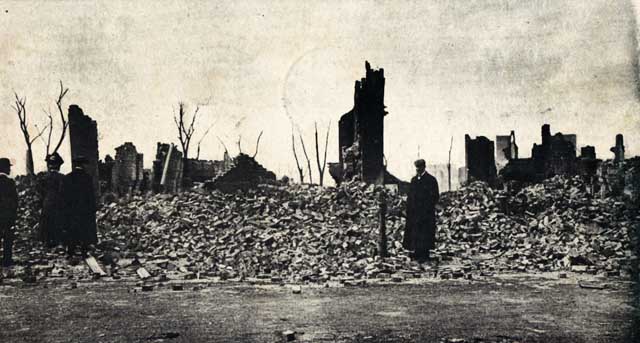
Ruins of the residential section on Chester Avenue after the big fire of April 12, 1908
Credit: Postcard published by N.E. Paper & Stationery Co., Ayer, Mass., 1908
|
Chelsea: City Of Opportunity |
|
Most of Chelsea's residents lived within a quarter mile of Broadway. However, language and religious differences effectively segregated the different ethnic groups. The Catholic Polish community settled near the harbor. The Jews established themselves in the mid-town area (although some streets were a mixture of Jew and Gentile.) The Protestant, American-born residents of northern European descendent laid claim to upper Broadway. Broadway in the southeast and railroad tracks in the northeast effectively separated their neighborhood from the Jewish section.
Even the shopping districts were distinct. Along Broadway there were fourteen butcher shops belonging to Gentiles, and no Jewish butchers. On Arlington Street, there were twelve Jewish butcher shops and no Gentile butchers. The Mill Hill section and Polish section of town were very anti-Semitic. Jews felt they were locked out of certain places and certain vocations because of this prejudice.
In 1905, the Jewish population of Chelsea was 4,500. Ten years later in 1915, the population had more than doubled with 11,000 Jews in the city. Most Jews worked in relatively high status occupations. They were carpenters, tailors, clerks, bookkeepers, coal dealer, lawyers, physicians, and journalists. Many of the Jews moved in from Boston during the building boom that followed a terrible Chelsea fire on Palm Sunday in 1908. The conflagration had swept through Chelsea and destroyed almost the entire business section and many houses.
|
|
|
Ruins of the residential section on Chester Avenue after the big fire of April 12, 1908 Credit: Postcard published by N.E. Paper & Stationery Co., Ayer, Mass., 1908 |
|
|
|
Looking up Broadway from Third Street Credit: Postcard published by N.E. Paper & Stationery Co., Ayer, Mass., 1908 |
|
|
|
All that remained of the Chelsea Armory, 1908 Credit: Postcard published by The Metropolitan News Company, Boston. |